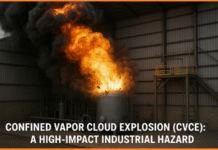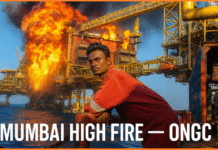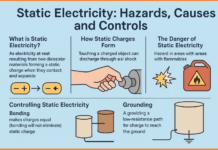To understand fire and explosion phenomena and their related subjects, following definitions are useful. Some Definitions Related to Fire
1. Auto-ignition (spontaneous ignition) Temperature is the temperature at which a material will self-ignite and sustain combustion in the absence of a spark or flame.
- Automatic Fire Alarm System is a fire alarm system comprising components and sub system required for detecting a fire, initiating an automatic alarm for fire and initiating other action as required.
- Combustibility (Flammability or ignitability) is the capacity of a substance to ignite and continue to burn in the presence of a heat source.
- Combustion or fire is a chemical change (reaction) accompanied by the evolution of heat and light.
- Control Centre is a permanently manned room preferably on ground floor within the premises at risk for the receipt of emergency calls and equipped with communications needed for transmission of calls assistance to services such as fire and police.
- Detonation is propagation of flames following shock wave through pipes, vessels, etc, at a very high speed (supersonic) and high localised pressure.
- Explosion is an extremely rapid chemical (explosive) transformation of fuel accompanied by release of energy and compression of gases capable of producing mechanical work.
- Extinguishing media are agents which can put out fires. Common extinguishing agents are water, carbon dioxide, dry chemical, alcohol foam, and water jet compound.
- Fire or combustion is a rapid oxidation-reduction reaction which results in the production of heat and generally visible light. A substance combines with oxidant and release energy. Part of the energy released is used to sustain the reaction.
- Fire Alarm System is a combination of components for giving an audible and visible and / or other perceptible alarm of fire. The system may also initiate other ancillary action. It includes manual call points for initiating alarm.
- Fire Point is the lowest temperature at which a mixture of vapour and air continues to burn when ignited.
- Fire Resistance is the ability of an element of building construction, component for structure to fulfil, for a stated period of time, the required stability, fire integrity and/or thermal insulation and /or other expected duty in a standard fire resistance test.
- Fire Resisting Wall is wall capable of specifying the criteria of fire resistance with respect to collapse, penetration and excessive temperature rise.
- Flammability Limits (Explosive range) the values (upper and lower) expressed in percent by volume of fuel vapour in air, is the range of concentration within which a particular vapour or gas mixture with air will burn (or explode) when ignited. Below the LEL the mixture is too lean to burn and above the UEL it is too rich to burn.
- Flameproof Enclosure is an enclosure for electrical machinery or apparatus that will withstand, when the covers or other access doors are properly secured, an internal explosion of the flammable gas or vapour which may enter or which may originate inside the enclosure, without suffering damage and without communicating the internal flammation (or explosion) to the external flammable gas or vapour in which it is designed to be used through any joints or other structural openings in the enclosure. (The term ‘explosion proof’ is synonymous).
- Flash back occurs when a trail of flammable gas, vapour or aerosol is ignited by a distant spark, flame or other source of ignition. The flame then travel back along the trail of fuel to its source resulting into fire or explosion.
- Flash fire is very rapid combustion.
- Flash point is the lowest temperature at which a liquid will give off enough flammable vapour at or near its surface, such that its mixture with air can be ignited by a spark or flame. It is of more interest in safety than the fire point.
- Fuel is a substance that acts as a reducing agent giving up electrons to an oxidiser (Oxygen in Air) in a chemical combustion. It may be an element like carbon, hydrogen, and magnesium etc, a single compound like CO, methane CH4, complex compound like wood or rubber or mixture like LPG.
- Ignition of flammable mixture takes place when it comes in contact with a source of ignition with sufficient energy or the gas reaches an auto ignition temperature and self (auto) ignites.
- Ignition Temperature is the lowest temperature at which ignition occurs in a mixture of explosive gas and air when the method specified in IS 7820 is followed. (Flash point is a higher temperature at which the most explosive mixture will ignite spontaneously on account of the environmental temperature).
- Material Factor of a substance is a measure of its energy potential and is a function of flammability and reactivity of the substance. The flammability depends upon the flash point or heat of combustion while the reactivity depends upon the instability of water. Higher is the Material Factor, higher is the fire and explosion hazard potential of a particular substance.
- Smoke Vents are openings, fitted with manual shutters for removal of smoke from a fire.
- Spontaneous Ignition or Combustion occurs as the result of the gradual development of heat generation by chemical changes. For example, baggas (grass) cubes heaped to be used as fuel, generate sometimes, spontaneous combustion without spark and resulting into fire. Similarly oil soaked rags can sometimes ignite without spark due to combining with oxygen (oxidation) evolving heat and if the heat given off reaches the apparent ignition temperature of the rags it may burst into flame and result in fire. Water spraying can avoid such phenomenon.
- Venting Fire is the process of inducting heat and smoke to leave a building as quickly as possible by such paths that lateral spread of fire and heat is checked fire fighting operations are facilitated and minimum fire damage is caused.





